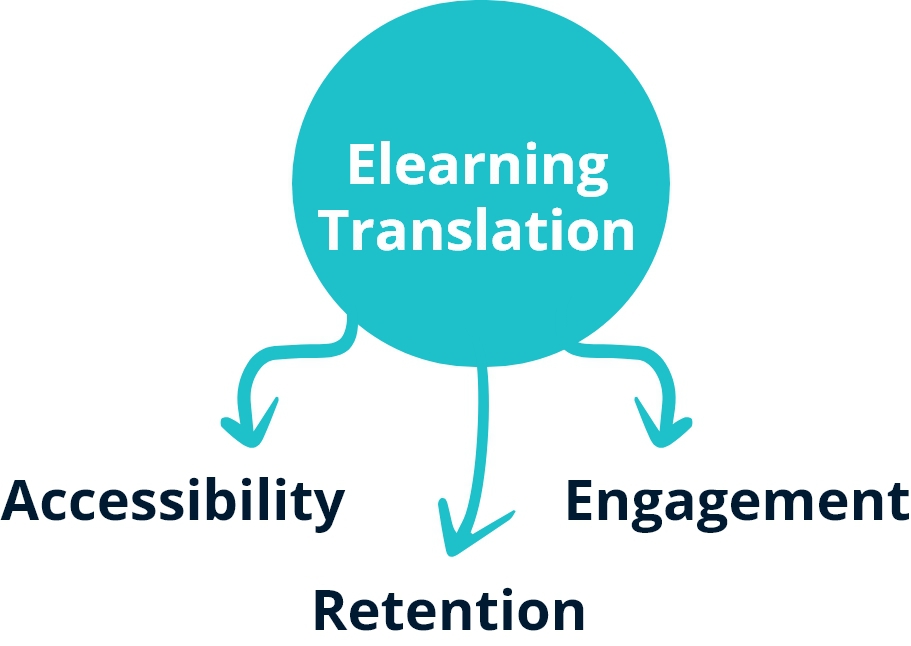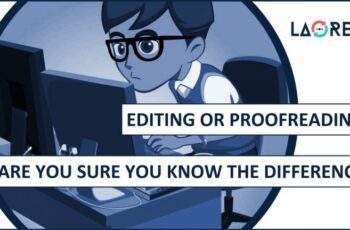Quality Assurance in eLearning Translation for Effective Learning Experience
Studies reveal that learning in one’s native language helps learners understand and retain information better. So, with over 100 million students worldwide enrolling in online courses, it’s only natural that the demand for eLearning translation is increasing.
However, just translating your eLearning materials from one language to another isn’t enough. Global learners require not only multilingual eLearning materials but a whole personalized learning experience.
But unless you have a robust quality assurance process in place, this mission can’t be accomplished.
What is quality assurance in eLearning translation? And why do you need it? That’s today’s topic.
What is Quality Assurance in eLearning Translation?
Before delving into the role of quality assurance in eLearning translation, Let us quickly review what eLearning translation is.
eLearning translation is the process of converting your eLearning content from one language to another to reach a new target market, but it goes beyond just translation.
It also entails eLearning localization, which requires thoughtful attention to the cultural nuances and technical intricacies of your text, video, audio, and interactive content.
The main purpose of eLearning translation and localization is to provide global learners with multilingual eLearning content that can maximize their learning potential, regardless of their languages or cultural background.
Whether you are offering an online course for learners worldwide or providing eLearning and training for your global workforce, your course and training materials should support different languages.
This way, you can ensure that your educational content is accessible and they can fully understand the material and achieve their learning objectives. Not only that, but this enhances engagement, retention, and productivity.

However, as previously mentioned, it’s not as simple as translating your text-based materials from one language to another.
It’s about the full experience.
eLearning essentially takes into account your course content, design, and functionality. No one thing can go without the other. Otherwise, the whole learning experience that your global learners are looking for can be compromised.

What is Quality Assurance in eLearning?
Quality assurance in eLearning is a comprehensive process that ensures your eLearning content is efficiently translated. This includes conveying the original course to a new target market and maintaining accuracy, precision, and consistency on the three levels, content, design, and functionality.
Quality assurance follows your multilingual eLearning translation step by step; from translating your course content and adapting audiovisual and interactive elements to rigorous testing.
This requires the synergy of expert people and advanced translation and QA technology.
You’ll need a qualified multidisciplinary team of subject-matter experts, linguists, designers, and DTP experts to ensure an accurate and effective multilingual eLearning course.
Here’s a glimpse into the translation and QA tools you’ll need for your eLearning translation projects.
- Translation Management System (TMS)
- Computer-Assisted Translation (CAT) Tools and Translation Memories
- Terminology Management Tools
- DTP Software
- Localization Testing Tools
Why do You Need Quality Assurance in eLearning Translation?
In its essence, quality assurance ensures your target audience has a seamless experience with your eLearning courses and feels like the material is customized just for them.
eLearning Quality Assurance includes
- Content Translation Accuracy
- Design and Visuals Localization
- UI/UX Localization
- Multimedia Localization
- Interactivity and Functionality
- Navigation and User Experience
- Compatibility and Responsiveness
- Data Security and Privacy
Thorough QA in eLearning translation verifies the completeness, correctness, and relevance of the translation. Most importantly, it verifies the integrity of the content, which can be highly specialized or technical, reducing the possibility of errors or misinterpretations.
Quality assurance also confirms the usability and performance of the eLearning platform, resulting in a flawless and user-friendly experience. In turn, this promotes a supportive and inspiring learning environment and increases enrollment.
So, what can an accurate quality assurance process add to your eLearning material? Let’s dig deeper.
4 Aspects that QA Considers in eLearning Translation
1. Content Accuracy
QA helps achieve optimal content accuracy, eliminating any confusion that could result from translation mistakes and misunderstandings.
This requires native-speaking language professionals with exceptional linguistic capabilities to conduct linguistic testing, performing multiple rounds of editing and proofreading that ensure no spelling, grammar, or any linguistic inaccuracies go undetected.
Moreover, depending on the subject matter of your eLearning course, be it manufacturing, medical, or marketing, you’ll need highly skilled industry experts who possess in-depth knowledge of the technical language and terminologies in question.
How Quality Assurance Ensure Content Accuracy
- Checking technical terminology and jargon
- Validating the use of acronyms and abbreviations
- Reviewing grammatical errors
- Correcting punctuation mistakes
- Verifying spelling accuracy throughout the text
- Reviewing sentence framing
- Ensuring consistency for fonts
- Checking spacing between words and paragraphs
- Assessing the tone of the narration
- Clarifying instructions that may convey confused meaning
2. Cultural Relevance
In eLearning course localization, quality assurance ensures the translated content is culturally appropriate and respectful of the target audience to resonate with learners on a deeper level.
It reflects their culture, values, and preferences in content, design and layout, color schemes, symbols, icons, and more.
For that to happen, you’ll need language professionals and cultural advisors who comprehend the diversity of how different countries interpret things. They should be deeply immersed in the target culture they are translating to and with first-hand insights into the relevant cultural sensitivities.
This way, they can ensure an authentic, meaningful eLearning experience that doesn’t alienate them, or worse offend them.
How Quality Assurance Ensures Cultural Relevance
- Ensuring the language and communication style resonates with the new cultural preferences.
- Using visuals and graphics that embrace cultural diversity and inclusivity.
- Checking if the humor and tone fit well within different cultural backgrounds.
- Reviewing the adherence to social norms specific to the cultural context.
- Sensitivity checks to avoid content that might be culturally taboo or offensive.
- Ensure content complies with the target culture’s laws and regulations.
3. Visual Consistency: Desktop Publishing (DTP)
A comprehensive DTP process in eLearning translation guarantees that the eLearning material not only conveys linguistically accurate information but also presents a visually engaging and culturally appropriate learning experience.
Through visual testing, the quality assurance phase ensures visual and layout accuracy, consistency, and coherency with the text and other course elements. It ensures they align with the original design and adhere to the glossaries and style guides.
How Quality Assurance Ensures Customized Desktop Publishing (DTP)
- Formatting and Layout Verification: ensures the translated content fits the layout, adheres to font styles, and maintains visual consistency with the original.
- Multilingual Typesetting: handles typesetting for different languages, ensuring proper display and legibility.
- Graphics and Images Localization: verifies accurate translation and localization of graphics and visual elements to suit the target audience’s culture.
- Multimedia Integration: synchronizes translated content with multimedia elements, ensuring accuracy and coherence.
- Hyperlinks and Navigation Check: verifies correct functionality and linking of hyperlinks and interactive elements.
- Text Expansion and Contraction Management: addresses text length constraints, content truncation, and overlapping text to ensure that the translated content fits seamlessly within the eLearning interface.
- Branding Consistency: checks for any deviations in the visual elements, graphic design, logos, colors, and tone of the translated content, maintaining the visual and tonal consistency of the original content across all translated versions.
4. Seamless Functionality
Although at first glance this seems like something outside the scope of eLearning translation, the functionality of your multilingual eLearning course is deeply connected to the entire learning experience”and thus is a crucial part of eLearning translation.
The role of QA at this point is to ensure a smooth and user-friendly experience for learners to access the course information easily and navigate effortlessly through it.
For example, interactive elements like quizzes and simulations that respond to learners’ actions are examined.
To overcome technical limitations, functionality testing takes into account content accessibility. It considers the specific resources available in the target countries, such as internet speeds and technology challenges, and adjusts the eLearning materials accordingly.
How Quality Assurance Ensures Seamless Access and Functionality
- Verifing the smooth functioning of all course elements.
- Conducting usability testing for easy learner access and a glitch-free experience.
- Ensuring compatibility across devices and operating systems.
- Implementing accessibility features for diverse learners’ needs, such as screen readers.
- Testing responsiveness to various screen sizes and resolutions.
- Validating interactive elements, like quizzes, for immediate and effective feedback.
5 Essential Tactics for
Effective eLearning Translation
We have developed a mini cheat sheet to guide you on successfully translating your eLearning content with the highest possible quality.
Laoret eLearning Translation Services: Ensure a Customized Experience For Your Global Learners
With extensive experience in the translation and localization industry, Laoret is leading the market by offering customized language solutions. Our experts help you go the extra mile by allowing your international customers to access your multilingual eLearning materials effortlessly.
We offer you the highest quality by adhering to ISO standards and covering you in more than 120 languages. Our multidisciplinary team of subject-matter experts, linguists, DTP, localization engineers, designers, and quality assurance specialists combine years of experience with the latest technology in the industry to guarantee efficient, fast, and affordable services.
So why wait? Request a quote from Laoret today and start delivering high-quality eLearning experiences to learners worldwide!






